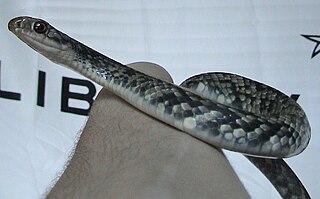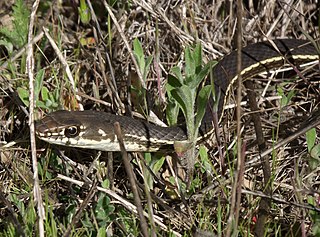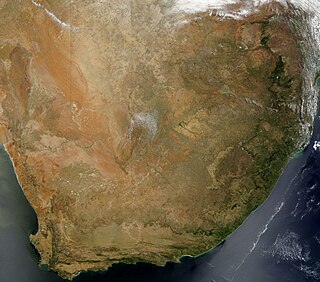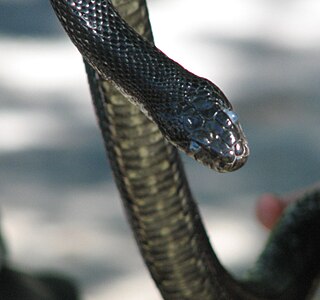
Kingsnakes are colubrid New World members of the genus Lampropeltis, which includes 26 species. Among these, about 45 subspecies are recognized. They are nonvenomous and ophiophagous in diet.

Pantherophis obsoletus, also known commonly as the western rat snake, black rat snake, pilot black snake, or simply black snake, is a nonvenomous species of snake in the family Colubridae. The species is native to central North America. There are no subspecies that are recognized as being valid. Its color variations include the Texas rat snake. Along with other snakes of the eastern United States, like the eastern indigo snake and the eastern racer, it is called “black snake”.

Belize is a country with a rich variety of wildlife, due to its unique position between North and South America, and a wide range of climates and habitats for plant and animal life. Belize's low human population, and approximately 8,867 square miles (22,970 km2) of undistributed land, provides an ideal home for more than 5000 species of plants, and vast numbers species of animals — with several hundred vertebrates including armadillos, snakes, and monkeys.

Coluber constrictor anthicus, commonly known as the buttermilk racer, is a subspecies of the eastern racer, a nonvenomous colubrid snake, endemic to the southern United States.

Coluber constrictor flaviventris, commonly known as the eastern yellow-bellied racer, is a subspecies of the eastern racer, non-venomous colubrid snake. It is endemic to North America.

The eastern racer, or North American racer, is a species of nonvenomous snake in the family Colubridae. The species is endemic to North America and Central America. Eleven subspecies, including the nominotypical subspecies, are recognized, which as a group are commonly referred to as the eastern racers. The species is monotypic in the genus Coluber.
Coluber constrictor etheridgei, commonly known as the tan racer, is a subspecies of nonvenomous snake in the family Colubridae, a subspecies of the eastern racer. The subspecies is native to the southern United States.

The banded water snake or southern water snake is a species of mostly aquatic, nonvenomous, colubrid snakes most commonly found in the Midwest, Southeastern United States and Caribbean.

Nelson's milksnake is a subspecies of king snake that is found in Mexico from southern Guanajuato and central Jalisco to the Pacific Coast. It is also found on the narrow plains of northwestern Michoacán and on the Tres Marias Islands. The range of this snake appears to be tied to the proximity of watercourses, including ones utilized for irrigation and agriculture. It is a subspecies of the milksnake, Lampropeltis triangulum. It is similar in size to other king snakes, averaging 42 inches (110 cm) long, and like them, it is nonvenomous.

The California whipsnake, also known as the striped racer, is a colubrid snake found in habitats of the coast, desert, and foothills of California.

The striped whipsnake is a species of nonvenomous snake in the family Colubridae. It is closely related to the California whipsnake. The striped whipsnake is native to the western United States and adjacent northern Mexico.
Black Racer may refer to:

Coluber constrictor foxii, commonly known as the blue racer, is a subspecies of Coluber constrictor, a species of nonvenomous, colubrid snake commonly referred to as the eastern racer.

The fauna of South Africa is diverse and largely typical of the ecosystems in Africa. South Africa is ranked sixth out of the world's 17 megadiverse countries. Many endemic species are unique to South Africa. The country is among the world leaders in conservation, but at the time wildlife is threatened by poaching and canned hunting.

Pantherophis alleghaniensis, commonly called the eastern rat snake, is a species of nonvenomous snake in the family Colubridae. The species is endemic to North America.

The northern black racer is a subspecies of the eastern racer, a nonvenomous snake in the family Colubridae. Their geographic range extends from southern Maine to northern Georgia and westward to central Kentucky and eastern Ohio. Their occupancy is dependent on the availability of large patches of open habitats.

























